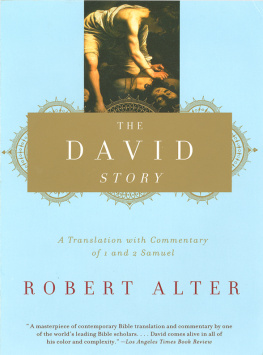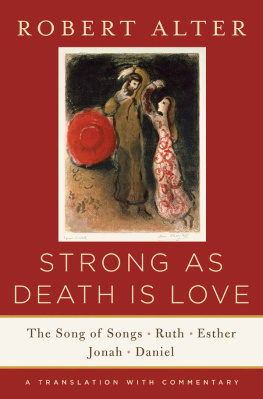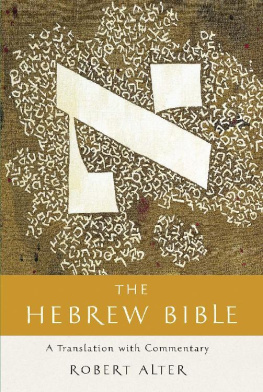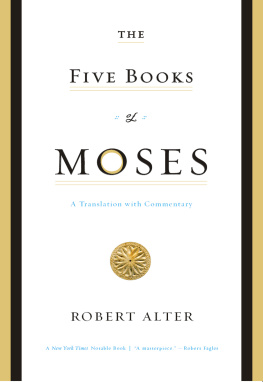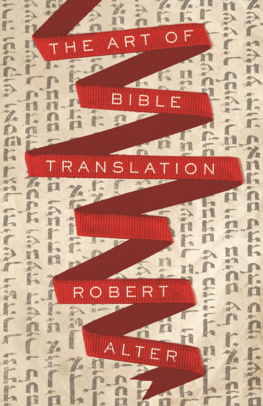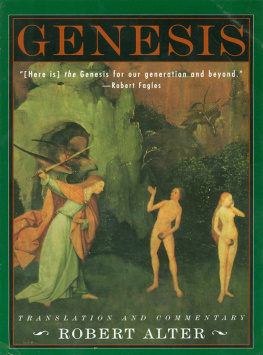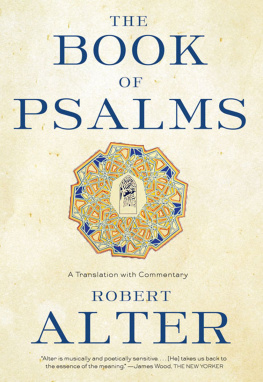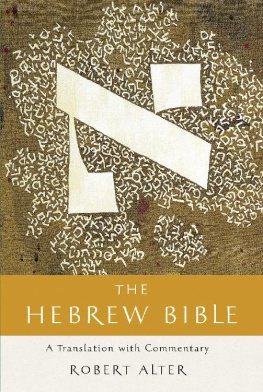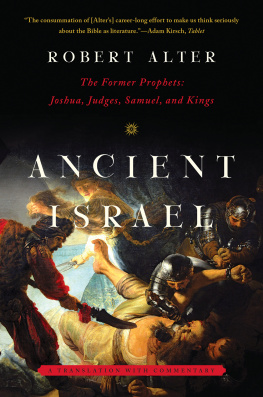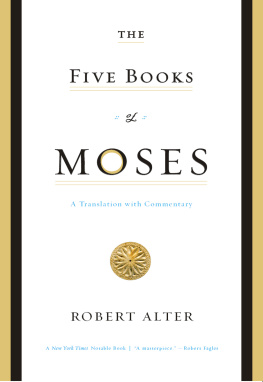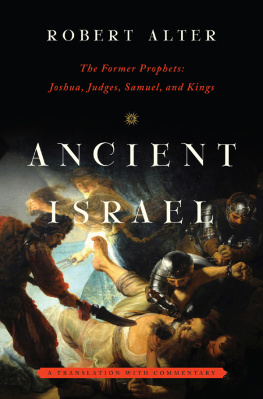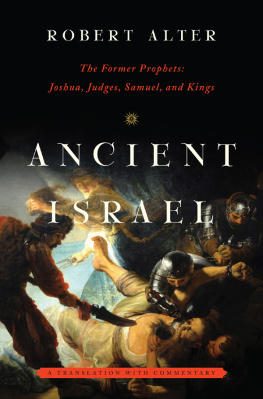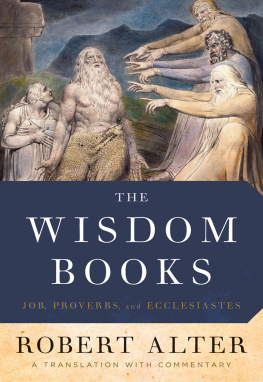T he manuscript was read with scrupulous care by Michael Andr Bernstein, Stanley Bumshaw, Carol Cosman, Steve Forman, and Thomas G. Rosenmeyer. I am fortunate to have had such intelligently attentive readers. They saved me from a good many lapses of judgment in the translation as well as sins of omission and commission in the commentary. In some instances, I stubbornly persisted in my own peculiar decisions despite suggestions to the contrary, so these wise counselors and friends should not be held responsible for anything that may seem amiss to certain readers. I am especially grateful to Steve Forman, my editor, for encouraging me in this project from the start and for offering several helpful general proposals about the presentation of the material. Although on questions of Hebrew philology I kept my own counsel, I did run a few of my original notions by Shalom Paul of the Hebrew University of Jerusalem, and I appreciated getting confirmation of my hunches from a scholar with such a splendid mastery of ancient Near Eastern languages and cultural contexts.
Secretarial and research costs were covered by income from the Class of 1937 Chair of Hebrew and Comparative Literature at the University of California at Berkeley, and a Humanities Research Fellowship from the Berkeley campus provided a sabbatical salary supplement that enabled me to take off a semester in order to complete preparation of the manuscript. Janet Livingstone did an admirable job in translating my scribbled drafts into elegantly readable computer printouts, with the commentary neatly answering the translated text above it.
ALSO BY ROBERT ALTER
GENESIS: TRANSLATION AND COMMENTARY
HEBREW AND MODERNITY
THE WORLD OF BIBLICAL LITERATURE
NECESSARY ANGELS: TRADITION AND MODERNITY IN KAFKA, BENJAMIN, AND SCHOLEM
THE PLEASURES OF READING IN AN IDEOLOGICAL AGE
THE LITERARY GUIDE TO THE BIBLE
(coeditor with Frank Kermode)
THE INVENTION OF HEBREW PROSE
THE ART OF BIBLICAL POETRY
MOTIVES FOR FICTION
THE ART OF BIBLICAL NARRATIVE
A LION FOR LOVE: A CRITICAL BIOGRAPHY OF STENDHAL
DEFENSES OF THE IMAGINATION
PARTIAL MAGIC: THE NOVEL AS SELF-CONSCIOUS GENRE
MODERN HEBREW LITERATURE
AFTER THE TRADITION
FIELDING AND THE NATURE OF THE NOVEL
ROGUES PROGRESS: STUDIES IN THE PICARESQUE NOVEL
A nd there was a man from Ramathaim-zophim, from the high country of Ephraim, and his name was Elkanah son of Jeroham son of Elihu son of Tohu son of Zuph, an Ephraimite. would torment her and she would weep and would not eat.
And Elkanah her husband said to her, Hannah, why do you weep and why do you not eat and why is your heart afflicted? . And it happened as she went on with her prayer before the LORD, with Eli watching her mouth, as Hannah was speaking in her heart, her lips alone moving and her voice not heard, Eli thought she was drunk. And Eli said to her,
?
Rid yourself of your wine!
, For from the LORD I asked for him.
And the man Elkanah with all his household went up to offer to the LORD there to the LORD.
The story of Hannah provides an instructive illustration of the conventions of narrative exposition that govern a large number of biblical stories. First the main character, or characters, are identified by name, pedigree, and geographical location. The only verb used is to be (verses 12). In this instance the standard biblical story beginning, there was a man, is in part a false lead because the real protagonist of the story is Elkanahs wife Hannah. Then there is a series of reported actions in the iterative tensethat is, an indication of habitually repeated actions (verses 37). (In all this, compare Job 1.) The narrative then zooms in to a particular moment, one of those annually repeated events of Hannahs frustration at Shiloh, by way of Elkanahs dialogue (verse 8), which could not plausibly be an iterative event. At this point, we have moved from prelude to story proper. The writer himself seems quite conscious of this play between recurring units of time and specific moments in time: the word yamim, days, but often as in verse 3 with the sense of annual cycle, is used five times, together with the singular yom, in an iterative sense, at the beginning of verse 4. (These recurrences are complemented by year after year, shanah beshanah, in verse 7.)
2.. The reference to two wives, one childbearing, the other childless, immediately alerts the audience to the unfolding of the familiar annunciation type-scene. The expected sequence of narrative motifs of the annunciation scene is: the report of the wifes barrenness (amplified by the optional motif of the fertile co-wife less loved by the husband than is the childless wife); the promise, through oracle or divine messenger or man of God, of the birth of a son; cohabitation resulting in conception and birth. As we shall see, the middle motif is articulated in a way that is distinctive to the concerns of the Samuel story.
3.. The reference is initially puzzling but points forward to the focus on proper and improper heirs to the priesthood in Samuels story.
5.. The Hebrew phrase, which occurs only here, means literally one portion [for the?] face, and has perplexed commentators. The conclusion of several modern translators that the phrase means only a single portion makes nonsense out of the following words that the allotment was an expression of Elkanahs special love. It seems wisest to follow a long tradition of commentators who take a cue from the doublative ending of apayim, the word for face (perhaps even a textual corruption for another word meaning double) and to construe this as a double portion to Hannah who, alas, unlike Peninnah, has no children.
7.. The Hebrew is literally thus did he do, but the impersonal masculine active singular is often used in this kind of passive sense.
. The Hebrew simply says she, but the antecedent is clearly Peninnah.
8. The double-edged poignancy of these words is that they at once express Elkanahs deep and solicitous love for Hannah and his inability to understand how inconsolable she feels about her affliction of barrenness. All the annunciation stories must be understood in light of the prevalent ancient Near Eastern view that a womans one great avenue to fulfillment in life was through the bearing of sons. It is noteworthy that Hannah does not respond to Elkanah. When she does at last speak, it is to God.
11.. Hannahs prayer exhibits a directness of style, without ornament or conventional liturgical phrasing, and an almost naive simplicity: if you give him to me, I will give him to you. This canceling out of the two givings is reconciled by the introduction of another verb at the end of the story: Hannah lends to God the child He has given her.
. As an expression of her dedication of the prayed-for child, Hannah vows that he will be a Nazirite (like Samson), a person specially dedicated to God who took a vow of abstinence from certain activities. (The literal meaning of the Hebrew is no razor will go up on his head.) The Nazirites also refrained from wine, which throws an ironic back-light on Elis subsequent accusation that Hannah is drunk. A few biblical texts link Nazirite and prophet.
14. The central annunciation motif of the type-scene is purposefully distorted. Since Hannah receives no direct response from Godshe prays rather than inquires of an oracleEli the priest should be playing the role of man of God or divine intermediary. But at first he gets it all wrong, mistaking her silent prayer for drunken mumbling, and denouncing her in a poetic line (marked by semantic and rhythmic parallelism) of quasi-prophetic verse. When in verse 17 he accepts her protestation of innocent suffering, he piously prays or predictsthe Hebrew verb could be construed either waythat her petition will be granted, but he doesnt have a clue about the content of the petition. The uncomprehending Eli is thus virtually a parody of the annunciating figure of the conventional type-scenean apt introduction to a story in which the claim to authority of the house of Eli will be rejected, and, ultimately, sacerdotal guidance will be displaced by prophetic guidance in the person of Samuel, who begins as a temple acolyte but then exercises a very different kind of leadership.

